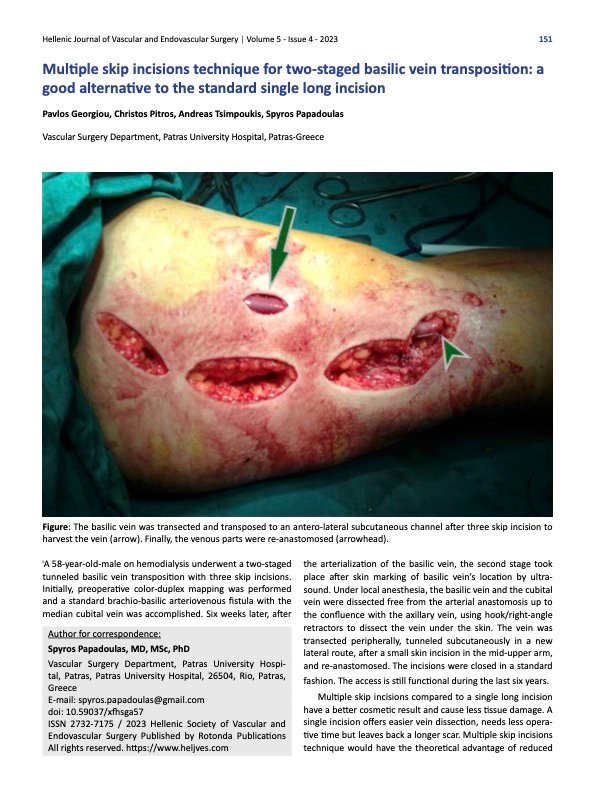Multiple skip incisions technique for two-staged basilic vein transposition: a good alternative to the standard single long incision

| Available Online: | October, 2023 |
| Page: | 148-149 |
Author for correspondence:
Spyros Papadoulas, MD, MSc, PhD
Vascular Surgery Department, Patras University Hospital, 26504, Rio, Patras, Greece
E-mail: spyros.papadoulas@gmail.com
doi: 10.59037/xfhsga57
ISSN 2732-7175 / 2023 Hellenic Society of Vascular and Endovascular Surgery Published by Rotonda Publications All rights reserved. https://www.heljves.com
Full Text
References
Images
Full Text
Figure: The basilic vein was transected and transposed to an antero-lateral subcutaneous channel after three skip incision to harvest the vein (arrow). Finally, the venous parts were re-anastomosed (arrowhead).
*A 58-year-old-male on hemodialysis underwent a two-staged tunneled basilic vein transposition with three skip incisions. Initially, preoperative color-duplex mapping was performed and a standard brachio-basilic arteriovenous fistula with the median cubital vein was accomplished. Six weeks later, after the arterialization of the basilic vein, the second stage took place after skin marking of basilic vein’s location by ultrasound. Under local anesthesia, the basilic vein and the cubital vein were dissected free from the arterial anastomosis up to the confluence with the axillary vein, using hook/right-angle retractors to dissect the vein under the skin. The vein was transected peripherally, tunneled subcutaneously in a new lateral route, after a small skin incision in the mid-upper arm, and re-anastomosed. The incisions were closed in a standard fashion. The access is still functional during the last six years.
Multiple skip incisions compared to a single long incision have a better cosmetic result and cause less tissue damage. A single incision offers easier vein dissection, needs less operative time but leaves back a longer scar. Multiple skip incisions technique would have the theoretical advantage of reduced postoperative pain, oedema and surgical site infection/dehiscence rates. This is supported in some reports1 but in others, although these complications were encountered infrequently, the difference did not reach statistical significance.2
References
- Jairath A, Singh A, Sabnis R, Ganpule A, Desai M. Minimally invasive basilic vein transposition in the arm or forearm for autogenous haemodialysis access: A less morbid alternative to the conventional technique. Arab J Urol. 2017 Mar 6;15(2):170-176. doi: 10.1016/j.aju.2017.01.004. PMID: 29071148; PMCID: PMC5653617.
- Shaikh FA, Nazeer S, Sophie Z, Shahzad N, Siddiqui NA. Multiple Skip Incisions Versus Single Long Incision for Single-stage Basilic Transposition Arteriovenous Fistula: A Cohort Study. Ann Vasc Surg. 2018 Jul;50:135-139. doi: 10.1016/j.avsg.2018.01.083. Epub 2018 Mar 5. PMID: 29518500.



